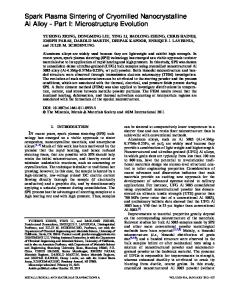Mechanical Behavior of Cryomilled Ni Superalloy by Spark Plasma Sintering
- PDF / 551,263 Bytes
- 7 Pages / 593.972 x 792 pts Page_size
- 30 Downloads / 344 Views
tra-fine-grained (UFG, 100 to 1000 nm) materials have been the subject of considerable research interest over the past two decades, in part because they represent a transitional size regime between nanostructured (e.g., 1000 MPa) was also achieved in the cryomilled 625 alloy, compared to the yield strength of 379 MPa in conventionally forged 625 alloy (grain size ~200 lm). In view of these findings, the motivation of the present work is to study the grainsize-dependent work-hardening behavior in the UFG regime. These results may ultimately be implemented to establish strategies to achieve high strength and good ductility in UFG materials. In this study, UFG 625 alloy samples with different grain sizes were prepared by the spark plasma sintering (SPS) technique. To diminish the potential effect of artifacts introduced during the process (e.g., porosity), compression testing is used to establish the work-hardening behavior. Gas-atomized INCONEL 625 alloy powders (Sulzer Metco (US) Inc., Westbury, NY) were cryomilled in a liquid nitrogen environment for 8 hours with a ball-topowder ratio 20:1. The experiment was conducted in a modified Union Process 1-S attritor (Union Process Inc., Akron, OH) at a rotation rate of 180 rpm, and more details are given in References 9 and 10. Chemical analysis of as-received and cryomilled INCONEL 625, listed in Table I, shows that the chemical composition fell within the nominal compositional range of INCONEL 625 alloy; Fe, O, N, and C, originated from the milling media, were slightly increased as a result of cryomilling. The cryomilled 625 alloy powder was consolidated in an SPS-515S apparatus (SPS Syntex Inc., Kanagawa, Japan). Prior to consolidation, the cryomilled powder was loaded in a cylindrical graphite die with an inner diameter of 15 mm, using two graphite plungers of the same size to seal the die on both ends and transfer the load during consolidation. Then the assembly was placed in a vacuum chamber and consolidated under a pressure of 42 MPa with a low voltage (98 pct) were achieved above 1173 K, as shown in the inset of Figure 1(b). At 973 K, the SPS sample attained a relative density of ~79 pct; at the temperature of 873 K, the SPS sintered powder did not form a solid compact. It should be mentioned that, although the SPS sintering only takes a few minutes, the SPS temperature required to achieve full density is lower than that for conventional sintering (e.g., hot pressed (HP) or hot isostatic pressed (HIP)). For instance, at a sintering temperature of 1533 to 1673 K, the sintered 2024—VOLUME 40A, SEPTEMBER 2009
density was reported to reach only 80 pct of theoretical density for a similar INCONEL 600 alloy.[11] In INCONEL 625 alloy consolidated using HIP, a density of 85 to 90 pct was obtained at a temperature of 1118 K.[12] Fast densification was also achieved with SPS in other material systems due to an acceleration of mass transport resulting from the presence of pulse currents.[13–18] To seal the porosity, the samples that were SPS consolidated at 1073 K were HP at 773 K
Data Loading...











